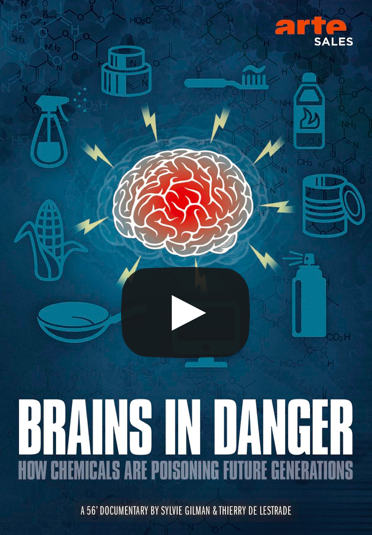December 2017 Newsletter – Great Gifts that Came Early
I trust you have had a good autumn. I’m just back from Thanksgiving in Kauai and hope to travel to Bali with my daughter Annalise for the December holidays (if the local volcano is quiet!). Annalise received her PhD from Tufts in August, writing her thesis on predicting floods and droughts based on stream flows. She is now a Post Doctoral Fellow at John Hopkins and living happily in Washington DC.
Our Institute’s work on flame retardants is featured in the French documentary “Demain, tous cretins?” or in English “Brains in Danger” which dramatically details how endocrine disrupting chemicals such as flame retardants are causing long-term health problems for us and for future generations.
Sylvie Gilman, who made the film, wrote enthusiastically:
“The film has already had 10 millions views. For a scientific film, this is fantastic. A Paris taxi driver told his passenger, who is my friend, that he had seen an amazing film and showed her the video on his mobile phone while driving!”
This film brings our message about protecting health from toxic chemicals to an international audience. Indeed the film’s website includes our Six Classes videos translated into French — a gift to broader understanding of reducing toxics!
- The CPSC landmark decision to implement our “Big Idea” petition and ban products containing the entire class of harmful organohalogen flame retardants.
- The City of San Francisco passed an ordinance banning the sale of upholstered furniture and children’s products containing any flame retardant.
- Publication of our scientist’s letter asking for study of impacts of highly fluorinated chemicals on communities with contaminated drinking water and funding for such studies included in the 2018 Defense Budget.
And if you want to join our Institute in working towards a healthier world, check out our jobs page. We are always looking out for great people to join our Institute. Please share this link with your friends.

Rob Bilott at last year’s symposium at UC Berkeley Photo by Gary Marcos
Save the Date: February 9, 2018
The Flame Retardant Dilemma and Beyond
-
Sharon Lerner, award-wining investigative journalist
-
Eve Gartner from Earth Justice who led the organoghalogen petition to the CPSC
-
Jay Fleming, fire safety expert from the Boston Fire Department
-
Johnsie Lang, EPA scientist specializing in highly fluorinated chemicals
Flame-Retarded Products Banned Nationally and Locally!
In a landmark decision on September 19, 2017, the U.S. Consumer Product Safety Commission (CPSC) granted our “Big Idea” petition to ban children’s products, furniture, mattresses, and electronics cases that contain any organohalogen flame retardants. This is a ground-breaking example of how government can use the chemical class concept for improved regulation of toxics.
To help prevent global pollution, Malene Teller Blume from the Danish Coop, who spoke at our February 2017 meeting at UC Berkeley, is leading a campaign for a national ban in Denmark of highly fluorinated chemicals and harmful bisphenols in food contact materials and other consumer products. After watching the powerful video to the right, Danes are taking action to ask for chemicals bans in Denmark and across the EU.
Awareness about highly fluorinated chemicals has come a long way since we released the Madrid Statement in 2015.
 Aerial Fire Retardants: It’s Raining Red
Aerial Fire Retardants: It’s Raining Red
Highly Fluorinated Hush Puppies?

Groundwater near a former leather tannery was recently found to have the highest levels of highly fluorinated chemicals ever measured in Michigan drinking water.
Wolverine Worldwide Inc. used 3M’s PFOS-based Scotchguard to waterproof its iconic Hush Puppies shoes on the banks of the Rogue River for decades until PFOS was phased out in 2002 due to its persistence, toxicity, and tendency to bioaccumulate. Recent tests of a household well near the tannery site found 540 times more PFOS and PFOA than the EPA’s recommended safe level — a staggering 37,800 ppt!
Wolverine’s manufacturing sludge and leather scraps continue to pollute water more than fifty years after their disposal! Once again we learn that such persistent chemicals need to be used with extreme caution and only when necessary. For more about this class of long-lasting pollutants, watch our short video here and check out our website here.
On a more positive note, our scientist’s letter on the need for a coordinated national response to the growing number of these contamination incidents was picked up by dozens of outlets in the US and Canada. At the same time, we are continuing to advise House and Senate staff from both sides of the aisle who have communities in their districts whose drinking water is contaminated with highly fluorinated chemicals. In fact, some of the provisions we suggest in the letter are included in the 2018 U.S. National Defense Authorization Act (NDAA).
Calendar
12pm-1pm, 534 Davis Hall, UC Berkeley
8:30am-4pm, 150 University Hall, UC Berkeley (2199 Addison Street, Berkeley CA)


